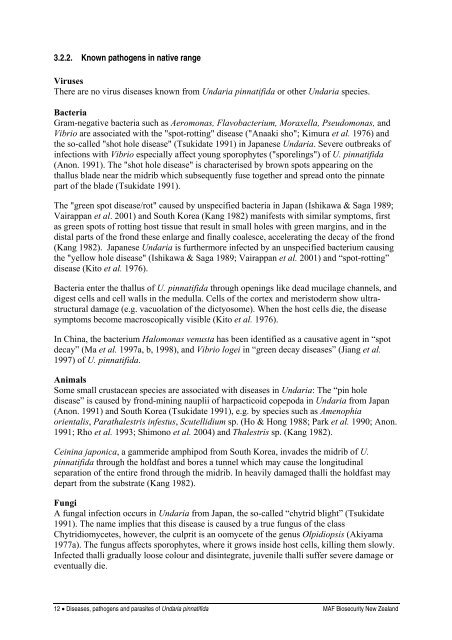Diseases, pathogens and parasites of Undaria pinnatifida
Diseases, pathogens and parasites of Undaria pinnatifida
Diseases, pathogens and parasites of Undaria pinnatifida
You also want an ePaper? Increase the reach of your titles
YUMPU automatically turns print PDFs into web optimized ePapers that Google loves.
3.2.2. Known <strong>pathogens</strong> in native range<br />
Viruses<br />
There are no virus diseases known from <strong>Undaria</strong> <strong>pinnatifida</strong> or other <strong>Undaria</strong> species.<br />
Bacteria<br />
Gram-negative bacteria such as Aeromonas, Flavobacterium, Moraxella, Pseudomonas, <strong>and</strong><br />
Vibrio are associated with the "spot-rotting" disease ("Anaaki sho"; Kimura et al. 1976) <strong>and</strong><br />
the so-called "shot hole disease" (Tsukidate 1991) in Japanese <strong>Undaria</strong>. Severe outbreaks <strong>of</strong><br />
infections with Vibrio especially affect young sporophytes ("sporelings") <strong>of</strong> U. <strong>pinnatifida</strong><br />
(Anon. 1991). The "shot hole disease" is characterised by brown spots appearing on the<br />
thallus blade near the midrib which subsequently fuse together <strong>and</strong> spread onto the pinnate<br />
part <strong>of</strong> the blade (Tsukidate 1991).<br />
The "green spot disease/rot" caused by unspecified bacteria in Japan (Ishikawa & Saga 1989;<br />
Vairappan et al. 2001) <strong>and</strong> South Korea (Kang 1982) manifests with similar symptoms, first<br />
as green spots <strong>of</strong> rotting host tissue that result in small holes with green margins, <strong>and</strong> in the<br />
distal parts <strong>of</strong> the frond these enlarge <strong>and</strong> finally coalesce, accelerating the decay <strong>of</strong> the frond<br />
(Kang 1982). Japanese <strong>Undaria</strong> is furthermore infected by an unspecified bacterium causing<br />
the "yellow hole disease" (Ishikawa & Saga 1989; Vairappan et al. 2001) <strong>and</strong> “spot-rotting”<br />
disease (Kito et al. 1976).<br />
Bacteria enter the thallus <strong>of</strong> U. <strong>pinnatifida</strong> through openings like dead mucilage channels, <strong>and</strong><br />
digest cells <strong>and</strong> cell walls in the medulla. Cells <strong>of</strong> the cortex <strong>and</strong> meristoderm show ultrastructural<br />
damage (e.g. vacuolation <strong>of</strong> the dictyosome). When the host cells die, the disease<br />
symptoms become macroscopically visible (Kito et al. 1976).<br />
In China, the bacterium Halomonas venusta has been identified as a causative agent in “spot<br />
decay” (Ma et al. 1997a, b, 1998), <strong>and</strong> Vibrio logei in “green decay diseases” (Jiang et al.<br />
1997) <strong>of</strong> U. <strong>pinnatifida</strong>.<br />
Animals<br />
Some small crustacean species are associated with diseases in <strong>Undaria</strong>: The “pin hole<br />
disease” is caused by frond-mining nauplii <strong>of</strong> harpacticoid copepoda in <strong>Undaria</strong> from Japan<br />
(Anon. 1991) <strong>and</strong> South Korea (Tsukidate 1991), e.g. by species such as Amenophia<br />
orientalis, Parathalestris infestus, Scutellidium sp. (Ho & Hong 1988; Park et al. 1990; Anon.<br />
1991; Rho et al. 1993; Shimono et al. 2004) <strong>and</strong> Thalestris sp. (Kang 1982).<br />
Ceinina japonica, a gammeride amphipod from South Korea, invades the midrib <strong>of</strong> U.<br />
<strong>pinnatifida</strong> through the holdfast <strong>and</strong> bores a tunnel which may cause the longitudinal<br />
separation <strong>of</strong> the entire frond through the midrib. In heavily damaged thalli the holdfast may<br />
depart from the substrate (Kang 1982).<br />
Fungi<br />
A fungal infection occurs in <strong>Undaria</strong> from Japan, the so-called “chytrid blight” (Tsukidate<br />
1991). The name implies that this disease is caused by a true fungus <strong>of</strong> the class<br />
Chytridiomycetes, however, the culprit is an oomycete <strong>of</strong> the genus Olpidiopsis (Akiyama<br />
1977a). The fungus affects sporophytes, where it grows inside host cells, killing them slowly.<br />
Infected thalli gradually loose colour <strong>and</strong> disintegrate, juvenile thalli suffer severe damage or<br />
eventually die.<br />
12 • <strong>Diseases</strong>, <strong>pathogens</strong> <strong>and</strong> <strong>parasites</strong> <strong>of</strong> <strong>Undaria</strong> <strong>pinnatifida</strong> MAF Biosecurity New Zeal<strong>and</strong>

















